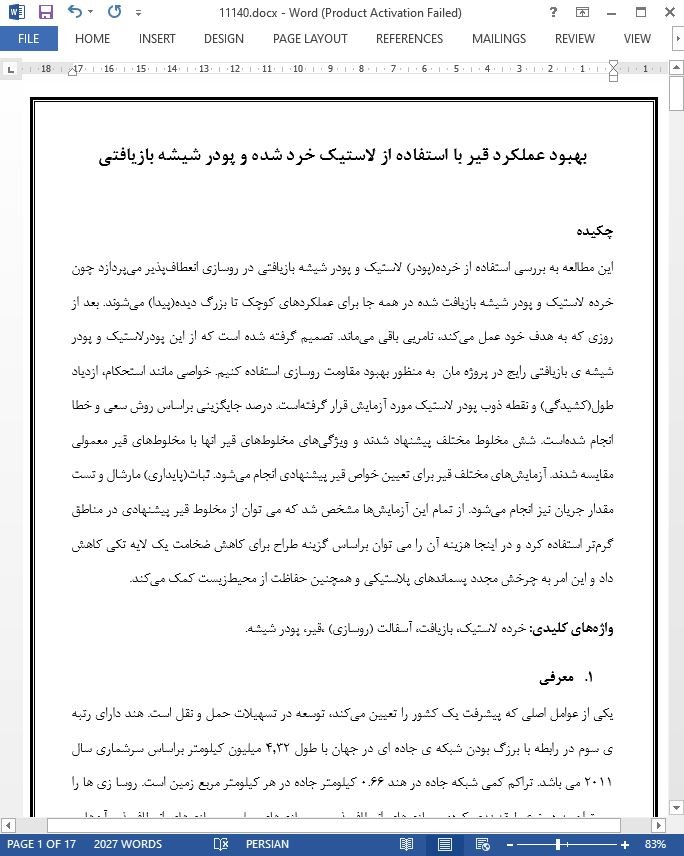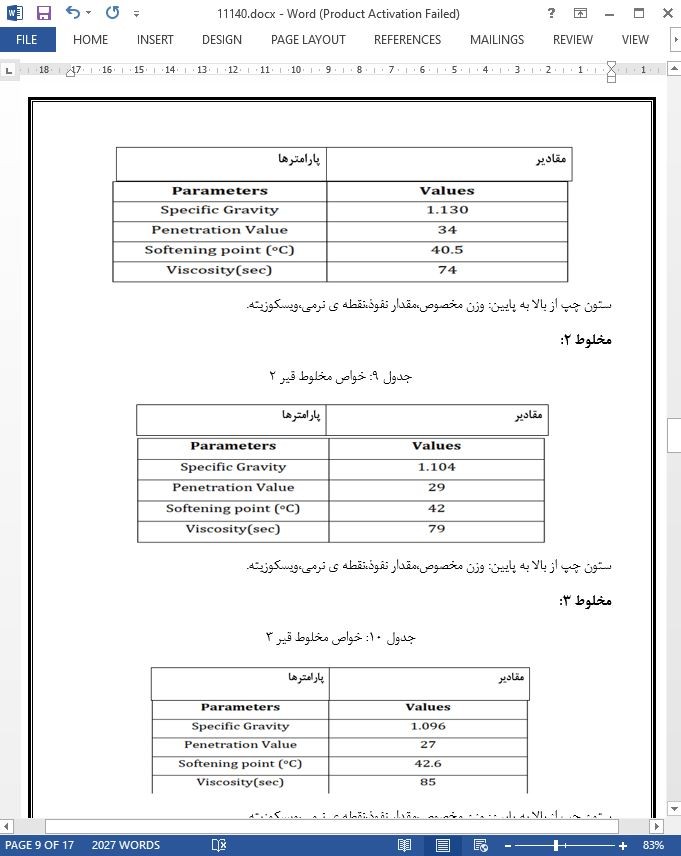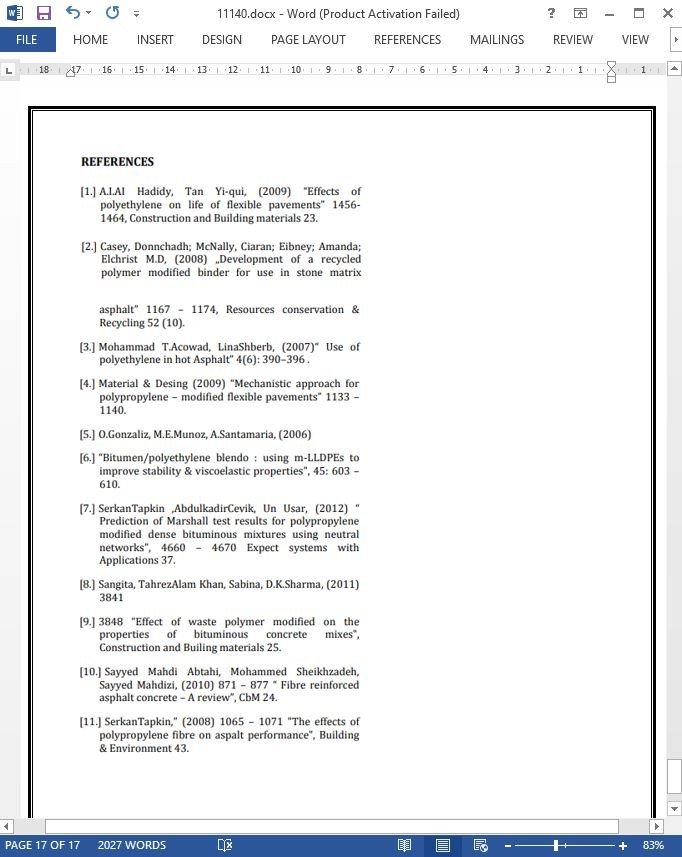
بهبود عملکرد قیر با استفاده از لاستیک خرد شده و پودر شیشه بازیافتی
چکیده
این مطالعه به بررسی استفاده از خرده(پودر) لاستیک و پودر شیشه بازیافتی در روسازی انعطافپذیر میپردازد چون خرده لاستیک و پودر شیشه بازیافت شده در همه جا برای عملکردهای کوچک تا بزرگ دیده(پیدا) میشوند. بعد از روزی که به هدف خود عمل میکند، نامریی باقی میماند. تصمیم گرفته شده است که از این پودرلاستیک و پودر شیشه ی بازیافتی رایج در پروژه مان به منظور بهبود مقاومت روسازی استفاده کنیم. خواصی مانند استحکام، ازدیاد طول(کشیدگی) و نقطه ذوب پودر لاستیک مورد آزمایش قرار گرفتهاست. درصد جایگزینی براساس روش سعی و خطا انجام شدهاست. شش مخلوط مختلف پیشنهاد شدند و ویژگیهای مخلوطهای قیر انها با مخلوطهای قیر معمولی مقایسه شدند. آزمایشهای مختلف قیر برای تعیین خواص قیر پیشنهادی انجام میشود. ثبات(پایداری) مارشال و تست مقدار جریان نیز انجام میشود. از تمام این آزمایشها مشخص شد که می توان از مخلوط قیر پیشنهادی در مناطق گرمتر استفاده کرد و در اینجا هزینه آن را می توان براساس گزینه طراح برای کاهش ضخامت یک لایه تکی کاهش داد و این امر به چرخش مجدد پسماندهای پلاستیکی و همچنین حفاظت از محیطزیست کمک میکند.
1. معرفی
یکی از عوامل اصلی که پیشرفت یک کشور را تعیین میکند، توسعه در تسهیلات حمل و نقل است. هند دارای رتبه ی سوم در رابطه با برزگ بودن شبکه ی جاده ای در جهان با طول 4.32 میلیون کیلومتر براساس سرشماری سال 2011 می باشد. تراکم کمی شبکه جاده در هند ۰.۶۶ کیلومتر جاده در هر کیلومتر مربع زمین است. روسا زی ها را می توان به دو نوع طبقهبندی کرد: روسازیهای انعطافپذیر و روسازیهای صلب. روسازیهای انعطافپذیر آنهایی هستند که تغییر شکل زیر لایه(بستر) و لایههای بعدی را به سطح منعکس میکنند. ویژگی صلب بودن روسازی با سختی یا مقاومت خمشی و یا عمل دال مرتبط است بنابراین بار در سطح وسیعی از خاک زیرین(بستر) توزیع میشود. سختی یا مقاومت خمشی و یا عمل دال مرتبط است بنابراین بار در سطح وسیعی از خاک زیرین(بستر) توزیع میشود. روسازی صلب در دال ها با آرماتور گذاشته شده است. بیشتر موارد استفاده در هند از نوع روسازی انعطاف پذیر است.
6. نتایج
نتایج بهتری برای جایگزینی بهینه ۶ درصد لاستیک خرده با وزن کل و ۶ درصد فیبر شیشه بازیافتی با وزن کل به دست میآید. لاستیک خرده و الیاف شیشه بازیافتی بسیاری از خواص قیر را اصلاح کردهاند و این پارامترها به شرح زیر هستند:
1.وزن مخصوص مخلوط قیر پیشنهادی با وزن مخصوص قیر معمولی برابر است.
2. مقدار نفوذ به 20 کاهش یافته است ، بدین معنی که قیر از درجه A90 و S90 به درجه A20 & S20 ارتقا یافته است. آن میتواند در برابر ضربه ی بیشتر مقاومت کند و میتواند مقاومت بیشتری در برابر wearing نشان دهد.
3. از مقدار نقطه نرمی مشخص است که قیر از درجه A۹۰و S۹۰ به درجه A۳۵و S۳۵ ارتقا یافتهاست. مقدار نقطه نرم شدگی به شدت افزایشیافته است و این نوع قیر را می توان در مناطق گرمتر که دما بیش از ۴۵ درجه سانتیگراد خواهد بود، استفاده کرد..
Abstract
This study investigates that the use of crumb rubber and recycled glass powder in the flexible pavement since the crumb rubber and recycled glass powder are seen everywhere for small functions to large ones. It remains unseen after the day it serves its purpose. It is decided to use this commonly wasted crumb rubber and recycled glass powder in our project provided to improve the strength of the pavement. The properties such as tenacity, elongation and melting point has been tested both the crumb rubber. Some replacement percentages have been carried out based on trial and error method. Six different mixes were proposed and the properties of those bituminous mixes were compared with conventional bituminous mixes. The various bitumen tests are to be carried out to define the properties of the proposed Bitumen. Marshall stability and flow value test also be carried out. From all these tests it is found out that the proposed bituminous mix can be used in hotter regions and here in the cost can be reduced based on the option exercised by the designer for reducing the thickness of an individual layer and it contributes to recirculation of plastic wastes as well as to protection of the environment.
1. INTRODUCTION
One of the major factors which determine the progress of a nation is the development in the transportation facility. India has the third largest road network in the world with the length of 4.32 million kilometers as per the census of 2011. The quantitative density of the road network in India is 0.66 km of road per square kilometers of land. The pavements can be broadly classified into two types i.e., Flexible pavement and rigid pavement. Flexible pavements are those which reflect the deformation of subgrade and the subsequent layers to the surface. The rigid characteristic of the pavement are associated with rigidity or flexural strength or slab action so the load is distributed over a wide area of subgrade soil. Rigid pavement is laid in slabs with reinforcement. The mostly adopted in India is flexible pavement.
6. CONCLUSION
Better results are obtained for an optimum replacement of 6% of crumb rubber by total weight and 6% of recycled glass fibre by total weight. Crumb rubber and recycled glass fibre has modified many properties of the bitumen and those parameters are as follows:
(i) Specific gravity of the proposed bituminous mix equals the specific gravity of the normal conventional bitumen.
(ii) Penetration value has been reduced to 20 which means, the bitumen has been upgraded to A20 & S20 grade from A90 & S90 grade. It could resist greater impact and could offer more resistance against wearing.
(iii) From the softening point value it is evident that the bitumen has been upgraded from A90 & S90 grade to A35 & S35 grade. The softening point value has been drastically increased and this type of bitumen can be preferred in hotter regions where the temperature would be more than 45oC.
چکیده
1. معرفی
2. آزمایش روی قیر
1.2 وزن مخصوص قیر
2.2 ازمایش نفوذ
3.2 آزمایش نقطه نرم شدگی
4.2 آزمایش ویسکوزیته
3. نتایج آزمایش قیر های متعارف
1.3 وزن مخصوص قیر
2.3 تست نفوذ برای قیر
3.3 نقطه ی نرم شدگی قیر
4.3 آزمایش ویسکوزیته روی قیر
5.3 مخلوط های آزمایشی برای قیر پیشنهاد شده:
6.3 نتایج قیرپیشنهاد شده
4. نمایش گرافیکی
1.4 ارزیابی وزن مخصوص
2.4 ارزیابی نقطه ی نفوذ
3.4 ارزیابی نقطه ی نرم شدگی
4.4 ارزیابی ویسکوزیته
5. آزمایش روی قیرهای روسازی
1.5 پایداری مارشال برای مخلوط معمولی
2.5 پایداری مارشال برای مخلوط قیر پیشنهادی
6. نتایج
Abstract
1. INTRODUCTION
2. Test on Bitumin
2.1 Specific Gravity of Bitumen
2.2 Penetration Test
2.3 Softening point test
2.4 Viscosity test
3. TEST RESULTS OF CONVENTIONAL BITUMEN
3.1 Specific Gravity of Bitumen
3.2 Penetration test for bitumen
3.3 Softening point of bitumen
3.4 Viscosity test on bitumen
3.5 TRIAL MIXES FOR PROPOSED BITUMEN
3.6 RESULTS OF PROPOSED BITUMEN
4. GRAPHICAL REPRESENTATION
4.1 VARIATION OF SPECIFIC GRAVITY
4.2 VARIATION OF PENETRATION VALUE
4.3 VARIATION OF SOFTENING POINT
4.4 VARIATION OF VISCOSITY
5. TEST ON BITUMINOUS PAVEMENT
5.1 Marshall Stability for Conventional Mix
5.2 Marshall Stability for Proposed Bituminous Mix
6. CONCLUSION
- اصل مقاله انگلیسی با فرمت ورد (word) با قابلیت ویرایش
- ترجمه فارسی مقاله با فرمت ورد (word) با قابلیت ویرایش، بدون آرم سایت ای ترجمه
- ترجمه فارسی مقاله با فرمت pdf، بدون آرم سایت ای ترجمه



